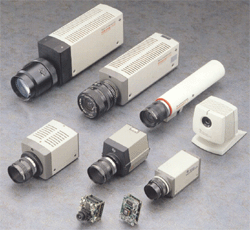Related Documentation:
> CCD Image Sensor Products
> News Releases
publications
> Technology Innovations
> Sine On Analog and Mixed-
Signal Catalog
trade shows
> Current Trade Shows
search news archives
> Search the News Archives
|
|
Texas Instruments' CCD Family With Integrated Image Intensification Enables Digital Imaging Devices to Virtually See In The Dark
 DALLAS (Jan. 23, 2001) -- A new family of charged-coupled devices (CCDs) from Texas Instruments Incorporated (TI) (NYSE: TXN) revolutionizes the image sensor market with single photon detection (SPD), a breakthrough technology that enables CCDs to see in extremely dim scenes. TI's SPD CCDs can be used to build high-sensitivity cameras that can detect a single photon. With the SPD CCD's integrated image intensifier, TI enables manufacturers to build smaller cameras with easier system integration at a lower system cost. These high-sensitivity CCDs are ideal for security and surveillance applications requiring high sensitivity and scientific applications requiring high precision. Additional imaging applications for these devices include industrial machine vision, astronomy, biochemical, traffic monitoring and military applications. (See www.ti.com/sc/disp for more details.)
DALLAS (Jan. 23, 2001) -- A new family of charged-coupled devices (CCDs) from Texas Instruments Incorporated (TI) (NYSE: TXN) revolutionizes the image sensor market with single photon detection (SPD), a breakthrough technology that enables CCDs to see in extremely dim scenes. TI's SPD CCDs can be used to build high-sensitivity cameras that can detect a single photon. With the SPD CCD's integrated image intensifier, TI enables manufacturers to build smaller cameras with easier system integration at a lower system cost. These high-sensitivity CCDs are ideal for security and surveillance applications requiring high sensitivity and scientific applications requiring high precision. Additional imaging applications for these devices include industrial machine vision, astronomy, biochemical, traffic monitoring and military applications. (See www.ti.com/sc/disp for more details.)
TI's SPD technology with integrated image intensification eliminates the need for external image intensifiers while enabling a wider spectral range, from deep ultraviolet to near infrared. TI's SPD CCDs now offer those applications that could not afford external image intensifiers, due to size and cost requirements, to benefit from image intensification performance. The SPD technology intensifies the image by multiplying the photon-generated charge using a low-noise impact ionization process before readout. The CCDs' dynamic range of over 90dB surpasses the dynamic range seen with most recent CCDs, giving designers up to 15 bits of meaningful data per pixel. TI's SPD technology, which can be applied to any known image sensor architecture, increases the sensitivity of standard CCD imagers by more than 50 times, and is capable of detection over a spectral range of 200 to 1,100 nanometers (nm).
"TI has set a new benchmark for CCD imaging with SPD," said Ichiro Fujii, product marketing manager for TI's digital image sensor products. "With the industry's ever increasing demands for high sensitivity, TI's SPD CCDs enable designers to add image intensification to applications without the large size and high cost previously associated with traditional image intensifier systems."
SPD is a proven technology that TI has been developing for several years. Previously, TI has provided this technology on a proprietary basis; however, the company is now releasing it to the commercial market. Additional benefits of the SPD CCDs include high speed and resolution, multi-mode readout capability and low dark current. The devices also demonstrate solid-state reliability with no-image burn-in, residual imaging, image distortion, image lag or microphonics.
Engineering samples of a camera based on the TC253, the first device of the SPD CCD family, are scheduled to be available in the second quarter of 2001. Engineering samples of the TC253 are scheduled to be available in the third quarter of 2001. The TC253 will be based on the architecture of TI's high-speed, VGA-format sensor, the TC237B, and will be demonstrated January 23-25, 2001, in Booth #2032 at the Photonics West Exhibition in San Jose, Calif.
# # #
|